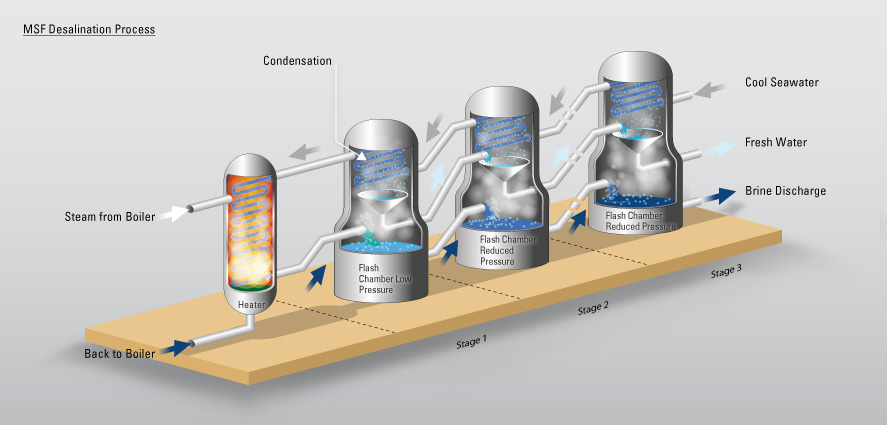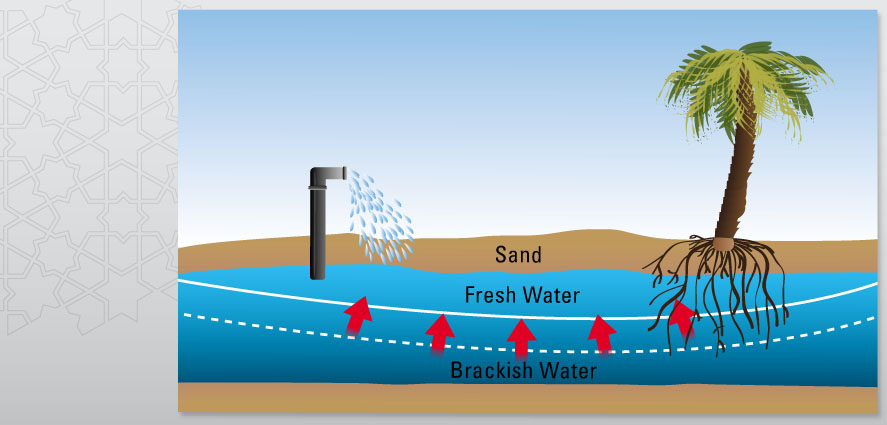
You are in :
Water crisis

Water Crisis
With demand for fresh water far outpacing natural supply, the Emirate is increasingly relying on desalination to manage the shortfall. With a population projected to reach four million in the next twenty-five years, there are limitations to current technologies, available energy and the environment's ability to absorb the impacts of this level of desalination.
Similar challenges face all southern Gulf countries, all of which draw from the same limited body of water as a source. Groundwater abstraction is equally unsustainable, with demand far exceeding the annual renewable supply. This looming water crisis requires careful understanding and a coordinated effort to solve.
Domestic Water Over-Consumption
Average Daily Minimum and Maximum Water Consumption (Litres/Person/Day)
Water Capacity and Demand (Million Gallons/Day)
















The measured rate of per capita domestic water consumption averages 565-920 litres/day (while the actual rate is likely to be higher) – double the rate of many developed economies – and is rising steadily. For example, the rate of per capita consumption in 1997 was 492 litres/day. By 2002, the rate had increased 53% (to 753 litres/day) before the introduction of a water tariff that year.
Since then, it has steadily increased and, if left unchecked, total annual demand could grow 123% by 2030. In the absence of new capacity, desalination will be unable to meet demand by 2014. With water costs highly subsidised by the government and little public awareness about water issues and their implications, there has been little incentive for water saving measures at the household level.
Desalination
Desalination removes dissolved minerals (primarily salt) from seawater, brackish groundwater or treated wastewater. Desalinated water in Abu Dhabi comes almost exclusively from co-generation power/desalination plants using thermal Multi-Stage Flash (MSF) technology. These co-gen power plants generate electricity using gas turbines, whose heat is used in the MSF process to ‘flash' boil seawater, creating steam. Condensing the steam produces fresh water, with the remaining briny water returned to the sea. In Abu Dhabi, most desalinated water is produced from six plants with a combined capacity of 683 million gallons/day. An additional 520 million gallons/day capacity will be added within the next few years.
The MSF desalination process demands large amounts of energy and in Abu Dhabi, this process primarily uses natural gas. However, when combined with a co-gen power plant, total energy requirements are reduced by 30–50%. The total inclusive cost of producing a cubic metre of desalinated water is roughly .04 USD. At the current rate of production, the price tag for Abu Dhabi's drinking water averaged over 0million per year from 2001 to 2006. The total cost of this government service will only grow as more desalination plants are built and energy costs continue to rise.
Rising Gulf salinity is a key challenge since it impacts the efficiency of the desalination process and increases the cost of water production. As the Gulf's salinity has increased, so has the cost of the desalination process and the produced water. Water transfer schemes to bring lower salinity waters from the Gulf of Oman are being explored but these are even more costly and are only temporary solutions.

Agriculture, Forest Plantations and Livestock
Livestock Population (Thousands)





Agricultural Farm Area (Thousands of Hectares)



Forest Plantation Area (Thousands of Hectares)





By far the largest portion of water consumption, about 68%, involves agriculture and forest plantations. These activities are highly constrained by negligible rainfall, high groundwater salinity levels, insufficient quantity and availability of suitable water and poor soil quality.
Forest ranges are typically irrigated with groundwater that ranges in quality and salinity levels from 4,200 to 40,000 mg/l. Acceptable tree growth can usually be attained with water of salinity levels of approximately 7,000 mg/l. In some instances, forests have been planted in areas where the groundwater quality is completely unsuitable for tree irrigation, and, in one case, forest development was halted due to salinities exceeding 35,000 mg/l.
Agriculture in the Emirate consumes about 1.74 billion m3 of groundwater each year or an astonishing 56% of all groundwater extracted. It is dominated by two perennial crops: dates and Rhodes grass, a feed crop. Rhodes grass alone consumes 600 million m3 per year, over 60% of all agricultural water use. Fodder from its production has supported a growing livestock population, now exceeding 2,650,000 head that consumes 20 million m3 of water per year.
Environmental Impacts of Desalination
The direct and indirect environmental impacts of desalination are significant and not always obvious. Increased salinity, temperature and discharged chemicals used in the desalination process directly impact marine species, putting the fragile ecosystem of the Gulf under stress. Every day, nearly 22,000kg of chlorine and 300kg of copper are discharged into the Gulf. Concentrated chlorine constrains photosynthesis in plankton, which sits at the base of the marine food chain. Copper settles in marine sediment, is consumed by benthic organisms and is ultimately transferred into the food chain. Anti scaling additives, used more intensively in MSF distillation, have been linked to devastating red tides.
Scientists now believe that elevated salinity levels are beginning to slow down the natural exchange of seawater between the Gulf and the Arabian Sea at the Strait of Hormuz. This process is essential to maintain the biodiversity and vitality of the Gulf's waters and is largely driven by the changing density of seawater, which generates a natural cycling of the waters. Without adequate mixing of Gulf waters, the Gulf may accumulate dangerous levels of pollutants from desalination, industrial discharge and other toxins that are harmful to marine life and human health.
Abu Dhabi's combined power and water plants generate about 13.5million tonnes of gases and particulates per year, which is 36% of Abu Dhabi's total emissions. Burning these fuels emits significant quantities of green-house gases, which are influential factors in climate change, especially global warming. The long-term consequences of desalination activities around the Gulf are being studied although it is already clear they are serious, regional in scope, and extremely costly to mitigate or manage.
Facts About Desalination in the Gulf







- Salinity levels in the Gulf are at around 45,000ppm (parts per million), about 10,000ppm higher than in open oceans
- Near desalination plants, salinity levels climb to 50,000ppm and sometimes 70,000ppm
- Temperatures of discharged effluent are around 10degrees Celsius higher than normal sea temperatures, even after they are mixed with cooling waters
- More than 58,000kg of anti-scaling additives are discharge daily into the Gulf through MSF
Quantity vs. Quality

The amount of truly fresh groundwater (with salinities up to 1,000mg/l) in the Emirate is quite limited and forms only about 11% of the total groundwater reserves. Where fresh water occurs, it is generally surrounded by moderately brackish water. Salinity levels tend to rise sharply as the water level declines, causing the influx of more saline water from lower levels in the aquifer and surrounding areas. The mixing of these high saline waters with fresher surface waters reduces water quality, as does liberal application of agricultural fertilisers, large numbers of livestock and localised dumping of brine and sewage effluent into the desert.

















